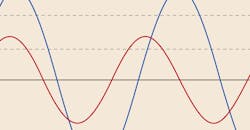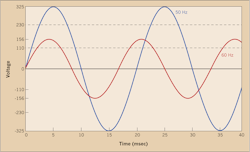Ranking Electrical Disturbances ― Part 5 of 7
This article is Part 5 of a seven-part series on the effects of power quality disturbances on a five-stage electronic LED driver. Part 1 (April 2018) dealt with long-duration voltage variations. Part 2 (May 2018) dealt with short-duration voltage variations. Part 3 (June 2018) focused on voltage and current transients (including surges). Part 4 (July 2018) dealt with the effects of voltage and current imbalances. This month, we turn our attention to power frequency shifts — or changes in the frequency of the voltage delivered to a customer facility.
Power quality disturbances are defined in terms of three quantities: amplitude, frequency, and wave shape. Most electronic designers are familiar with amplitude and frequency, especially as these relate to the standard “textbook” sinusoid wave of voltage. However, wave shape is a relatively new term for design engineers. It’s an important term in the world of power quality. Wave shape defines many aspects of the disturbance, including the type (steady-state or transient). It’s also important in determining what’s happening with a specific power quality phenomenon.
However, with respect to power frequency shifts, frequency is the most important defining term. The standard power frequency in the United States is 60 Hz, which means the stimulus (i.e., voltage sine wave) changes (i.e., completes its mathematical period) 60 times per second. (The old terminology is 60 cycles per second.) Many foreign countries use 50 Hz as their standard power system frequency. Figure 1 illustrates an example of both 50-Hz and 60-Hz voltage sine waves.
With one of the first electric loads being incandescent lamps, the voltage and frequency of the voltage were (and still are today) important with respect to lamp performance. Overall, 50-Hz and 60-Hz frequencies are very low frequencies. Because of this, the temperature of the filament as well as the brightness of the lamp will vary significantly as the frequency changes. Incandescent lamps will also respond with a lamp flicker when the voltage source (stimulus) is changed from 50 Hz to 60 Hz. Because high-intensity discharge (HID) lamps require the use of a ballast (or transformer, called a magnetic HID ballast), the frequency of the voltage is extremely important. However, most HID ballasts still available today will operate on voltage sources that are 50 Hz or 60 Hz.
Designers of electronic power supplies (such as switch mode power supplies) used in all desktop and laptop computers are more familiar with the power frequency effects on their power supplies as opposed to designers of LED drivers. In many ways, electronic power supplies for LED drivers are like electronic power supplies for computers. Figure 2 shows the simplified block diagram for an LED driver with five stages.
What parts of the driver might be sensitive to the power frequency? The answer is “parts that involve the ‘processing’ sinusoidal energy or use of the sine wave before it’s converted into DC energy.” These parts include the EMI filter, rectifier, DC filter stages, and maybe the power factor correction (PFC) stage.
The EMI filter involves the use of magnetic, capacitive, and inductive components to establish the correct amount of filtering required to reduce the conducted emissions below levels required by the U.S. Federal Communications Commission and organizations such as CISPR [International Special Committee on Radio Interference (English version)], which are mandated to regulate high-frequency emissions generated by electronic products. One of the design criteria for EMI filters is based on the power frequency range — most commonly 50 Hz to 60 Hz with maybe a 0.1-Hz to 1.0-Hz deviation (in the utility generating frequency). However, when the power frequency shifts above or below 60 Hz (or 50 Hz), one may encounter unacceptable performance of the EMI filter. Most shifts in power frequency are short-lived, lasting less than a cycle to a few cycles before returning to nominal (50 Hz or 60 Hz). In some cases, though, the shift may last much longer, if an unusual power quality phenomenon is occurring. Hopefully, any “long-term” shift doesn’t last too long. Why? Shifts in power frequency for long periods can have dramatic effects on the magnetic components of EMI filters.
The bridge rectifier is also exposed to the power frequency sine wave. The rectifier, whether made of discrete components or a bridge, is responsible for rectifying the voltage. This means that the rectifier “flips” the voltage wave segments (up for positive rectification). The rectification process will not be affected by the power frequency, whether it’s 50 Hz, 60 Hz, or some other shifted frequency, if the amplitude remains constant.
Standardized (traditional) filters made of a simple R (resistive) and C (capacitive) combination as “smoothing” filters for the rectified sine wave will provide a different filtered DC voltage when the power frequency is 50 Hz as opposed to 60 Hz. Thus, if a power quality phenomenon occurs, resulting in a “long-term” shift of the power frequency, the DC voltage at the output of the filter could be affected, depending on the degree of the shift. This will depend on the type of power supply control system employed in the LED driver. Design engineers should test their drivers for shifts (intermittent, or short-lived and long-term) in the power frequency to ensure no unacceptable effects, such as flicker, are observed on the driver’s performance and at the LED light output.
Lastly, the performance of the PFC stage is important when considering shifts in the power frequency. Power electronics are used in this stage, and the effects of the shifts on the power electronics should be investigated through simulation and testing before a driver design is finalized.
Shifts in the power frequency will become more common as the number of distributed generation (DG) resources (e.g., solar photovoltaic farms, microturbine farms, wind farms) are deployed across the grid. Figure 3 illustrates the shift in the power frequency on a 50-Hz system when a DG unit is islanded. Shifts in the power frequency are not frequently recorded in distribution power systems with little to no DG. The use of emergency generators at commercial customer sites are one of the more common sources of power frequency shifts, especially if there are problems with the generator synchronizing to the electric utility voltage or if there are problems with the automatic transfer switch (ATS), which is part of the customer’s emergency power system.
Keebler is a power systems and power quality engineer and can be reached at [email protected].
About the Author
Philip Keebler
Senior Power Quality Engineer
Philip F. Keebler, MSEE has 32 years of experience in power quality (PQ) having worked for North American Philips, Electric Power Research Institute (EPRI), Electrotek Concepts & Dranetz. His experience spans across the utility revenue meter addressing PQ problems on the grid and inside residential, commercial and industrial customer facilities. His specialty areas include grounding, disturbances, harmonics, electromagnetic interference (EMI), equipment immunity, PQ monitoring, training and standards development. He serves as a Technical Advisor to PBE Engineers, LLC focused on understanding, identifying, solving and preventing (UISP) PQ problems in the industry and fostering new interest and workforce development to attract young engineers to developing careers in PQ. He can be reached at [email protected].



